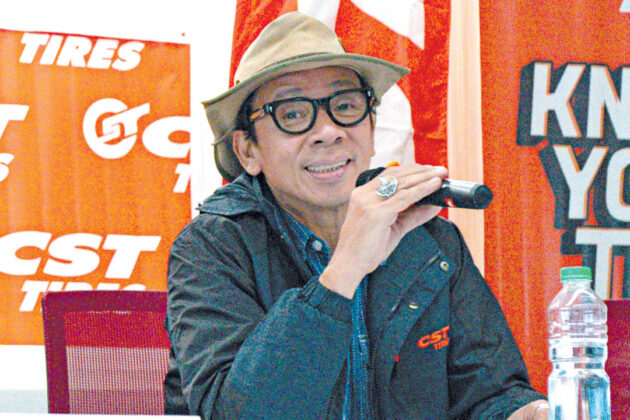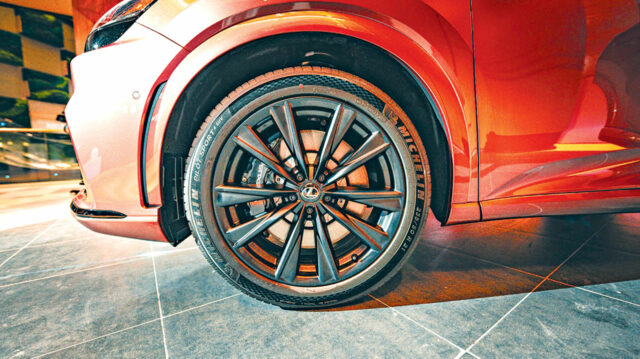You wanna be on top? The model life
By Joseph L. Garcia, Senior Reporter
FORGET parents and lovers. Who really guides you with how to live your life are the models smiling from your screens, or looming at you from billboards larger than life. They’re not actually telling you anything, but the clothes they wear, and the yogurt they’re not actually eating presents you with a picture of how a life should be lived. What they’re showing isn’t always particularly true, or realistic, but it’s always good to reach for a star.
Models (most of them uniformly sized and quite tall) were all at Dr. Wine in Makati’s Poblacion for a brand and socials night on Aug. 6. Their ringleader, Diego Harmuch, Chief Executive Officer and founder of Luminary Model Management, Inc., was dressed in a suit and told BusinessWorld what it’s like to live that life.
The modeling agency started scouting in 2020 but was officially launched in 2021. Since then, their models’ faces and bodies have graced the pages and covers of international magazines, and store windows of global fast-fashion brands.
GETTING THERE
Mr. Harmuch told us the steps to getting hired as a model.
First you get scouted, or you get referred, or you can apply to a modeling agency, or you can attend an open casting (they’ve just finished one: 86 aspirants came in, only two women got the job). If they like your profile, they schedule an interview. Then, they arrange a photoshoot so they can fill up your comp card: like a calling card for models, but aside from biographical data, it contains the model’s measurements and pictures. These include full-body and half-body shots, close-ups, and snapshots. “What closes the job are the snapshots; clean shots. You need to see how the models really are when they have no makeup, and they are not produced,” said Mr. Harmuch. These comp cards are then shown to clients and casting agents.
But what should a model look like? It still depends on the market.
“I remember modeling in the Philippines 10 years ago. The market was very different,” Mr. Harmuch said. Himself possessing a lean frame, the casting agents and brands back then looked for more muscular builds. “It’s (now) much more open. I believe anyone can become a model, as long as they really want to do it,” he said. “And of course, (if) you have the certain measurements that you need to have.”
He gives some examples: a female model would be around 5’6” to 5’7”, but that’s variable (again, it depends; a phrase Mr. Harmuch used a lot in this interview). The shorter girls can do beauty, skin, and clothing campaigns, but, “We have girls who are taller, who are suitable for fashion shows.”
If the model is doing beauty campaigns, they have to have great skin. For other areas, it’s a lot more nebulous: “You need to fit the clothes very well,” he said. “The clothes have to look good on you. You’ve got to have good proportions.” He added, “We look for different faces, now that the market is very open.”
X-FACTOR
Scouting a model might feel a bit like falling in love (though Mr. Harmuch thinks the feelings are different). “I think it’s like an X-factor,” he said. “You see potential. You see raw potential in that person. You see what a person can possibly become.
“You see a person, and you really believe that that person can be a model. You know what I mean? And then it just happens to them,” he said. “That person was born to be a model. Just guide that person properly… put them in the right place.”
Mr. Harmuch had been a model himself, starting at age 14. He took pictures with his cousin, who sent them to a modeling agency. Asked if this was proof that he had always been good-looking, he said, “I mean… that I don’t know. It just happened.”
While head of a modeling agency, he’s also a photographer. Asked what it’s like on the other side of the lens, he said, “There’s a lot more planning. You really have to plan, and know that you are dealing with people’s lives. It’s a bigger responsibility.”
THE MODEL LIFE
We interviewed some of his models: Hazel Xue was studying public relations in Australia and decided to do something a bit more casual and part-time to make money, and still have fun. “When things started to become a little bit more serious, I saw my potential in this industry,” she said. She stands in front of a mirror sometimes to practice posing, or does research on her favorite international models to see how they do it.
Male model Diego (who asked for his last name to be a simple “M”) said about his discovery, “Classic story. I was walking in a mall.” In SM Cherry, in Mandaluyong, of all places. A designer approached him and asked if he was a model. He said no. The designer asked if he wanted to be a model. He said no. “I really had nothing in my plans to be a model,” he said. The designer posted his picture on Facebook, where it was spotted by Mr. Harmuch and his wife.
“I wanted to be a chef,” said Mr. M. “I’m doing this first before that, because I know modeling doesn’t last very long. My true passion is cooking. Modeling became also like a hobby and passion over time.
“I love it. It’s just a world that I was never exposed to,” he said. Mr. M, 21 years old, tried to explain the politics of the Second World War, ending by saying that his European father turned socialist. “They were anti-capitalism; all this, that’s all in my head. This world is new to me.”
ON DIETS AND TRAVELING
Young, good looking, traveling the world (Mr. M had done a show on Milan Fashion Week), and your only tax to enter this world is your face. Life as a model should be easy, but Mr. Harmuch said in a low voice, “Not really.”
“First thing, it’s a 24-hour job. You always have to (fulfill) measurements. You always have to look a certain way. You have to work hard for that,” he said.
Salads and assorted cheese and charcuterie were served as the first course of that evening, as well as foie gras on different kinds of bread. A server, laughing, aware of the models surrounding the table, said that the bread may be left untouched, because of the models’ diets. One (Mr. M, actually), said, “Kakainin ko iyan (I’ll eat that).”
“It’s not easy for you to be doing a diet every day,” said Mr. Harmuch. “To restrict yourself from eating certain things that you want to eat.
“Or being away from your family,” said Mr. Harmuch who recalled leaving home at 18 to model around the world. “Literally not seeing your parents and you’re a very young teenager. Being away from your family — it’s very lonely, actually. Traveling around… it’s hard. There are a lot of struggles, that a lot of people don’t understand. They think you just have to be pretty. There’s hardship,” he said.
“Not a lot, to be honest,” said Mr. M, when asked about the hardest parts of modeling. “Compared to photographers, and all that. They do all of the work, essentially. You just show up. You don’t really have to prepare. You just prepare yourself.
“I guess the hardest part is keeping your body in shape, and making sure you’re eating healthy, and making sure that everything is as picture-perfect as can be,” he said.
For Ms. Xue, who is “a little bit introverted,” the hardest part was facing people. “Sometimes, when I need to talk to people, I find it to be stressful. But when I open up, and people are so friendly, I find it is easy.”
“Nobody’s job is easy. Everyone is just trying to go through it,” he said. What then, makes it all worth it? “What makes it worth it?” said Mr. Harmuch, repeating our question. “You love it. You have to love it. I think when you really love something, you do it because you love it. It happens to you because it’s supposed to be there, like that. It’s hard to answer this question.”
A BLESSING
Is it worth it when you see your face everywhere, presented larger than life itself? “You have to be very humble when it happens to you. I always tell my models to be very humble. If God blesses you, these things happen to you.”
Former model, photographer, and he who sat on the judges’ panel of America’s Next Top Model Nigel Barker said in the introduction to his book, Models of Influence, “Models have moved us over the years to think and see the world differently. They hold up a mirror to society and show us where we are and where we still have room to grow. What is considered beautiful evolves, but it’s very often through models and fashion that we come to understand beauty in the context of our time, and by extension, within ourselves.”
Mr. Harmuch says, “Modeling is about being your own personality, and becoming more of who you are, so you can be an inspiration for other people.”














